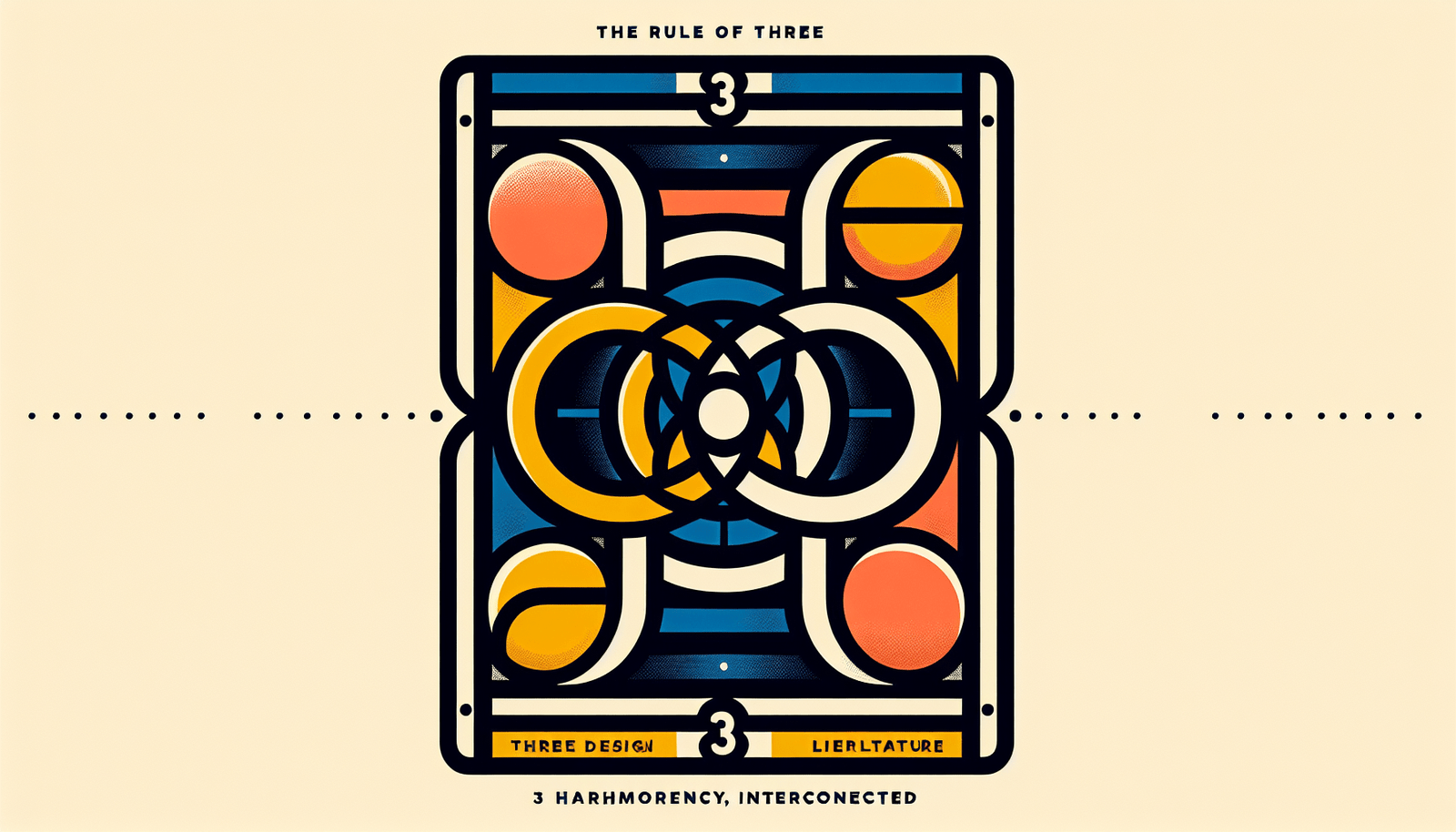Have you ever noticed how many things in life seem to come in threes? Whether it’s fairy tales, famous speeches, or even marketing strategies, the rule of three is everywhere. Why is the rule of three so powerful? This seemingly simple concept holds a profound influence over the way we perceive and interact with information, impacting areas from communication to memory.

What is the Rule of Three?
The rule of three is a writing principle that suggests ideas, concepts, or words are more satisfying and effective when presented in threes. This principle is rooted in human psychology and can be traced back to ancient storytelling and rhetoric.
The Origins
The rule of three has deep historical roots. Ancient Greeks and Romans used it in their compositions to make speeches and stories memorable and persuasive. Aristotle himself noted the importance of using three elements to make an argument more compelling.
Simple Yet Memorable
The essence of the rule of three lies in its simplicity. Our brains are wired to find patterns and sequences of three easier to remember and process. Whether it’s “Veni, Vidi, Vici” or “Life, Liberty, and the Pursuit of Happiness,” sets of three elements leave a lasting impact.
The Psychological Power of Three
Understanding the psychological power behind the rule of three can offer insight into its effectiveness. Our brains are naturally drawn to patterns, and the number three seems to be the smallest number needed to create a pattern.
Pattern Recognition
Human brains are pattern-recognition machines. We are constantly looking for order and simplicity in the midst of chaos. The number three provides just enough variety to be interesting while still being simple enough for easy processing.
The Comfort of Completeness
When things come in threes, they feel complete. Consider phrases like “beginning, middle, and end,” which encompasses the full structure of a story. This completeness makes the information more easily digestible and satisfying.
The Rule of Three in Storytelling
Storytelling relies heavily on the rule of three. From ancient myths to modern movies, the structure of three is a constant theme. It forms the backbone of many narrative arcs and can make stories more engaging.
Three-Act Structure
One of the most common applications in storytelling is the three-act structure. Almost every story you encounter follows this pattern: setup, confrontation, and resolution. This structure provides a clear path for the narrative to follow, making it easier for the audience to engage with the story.
Memorable Characters and Events
Think of famous stories and characters: The Three Little Pigs, Goldilocks and the Three Bears, or even the trio of Harry, Hermione, and Ron in Harry Potter. When elements come in threes, they become more memorable and impactful.
The Rule of Three in Communication
Effective communication often employs the rule of three to ensure messages are clear and compelling. This is especially true in public speaking, advertising, and even educational settings.
Public Speaking
Many great speeches use the rule of three to emphasize their points. Consider Martin Luther King Jr.’s “I Have a Dream” speech: “Free at last, free at last, thank God Almighty, we are free at last.” The repetition and triadic structure drive the message home powerfully.
Advertising and Marketing
In marketing, slogans and campaigns often utilize the rule of three to make their messages stick. Think of slogans like “Just Do It” (Nike), “I’m Lovin’ It” (McDonald’s), or “Finger Lickin’ Good” (KFC). These succinct, three-element phrases are easy to remember and resonate with audiences.
Education and Learning
In education, teachers often break information down into three parts to help students better absorb and retain knowledge. For instance, a lesson plan might consist of an introduction, a body, and a conclusion.

The Rule of Three in Writing
Writers also benefit from the rule of three, whether they are crafting novels, articles, or even poetry. Using three elements can make their writing more rhythmic and appealing.
Triadic Sentence Structure
Using a triadic sentence structure can enhance the rhythm of your writing. For example, “She hoped, she dreamed, she achieved.” This structure can add a natural flow to your sentences, making them more enjoyable to read.
Lists in Threes
Lists become more effective and memorable when limited to three items. Instead of overwhelming your audience with a long list, focusing on three key points makes the information more digestible.
Making the Rule of Three Work for You
Now that you understand the significance and power of the rule of three, how can you make it work for you in various aspects of your life?
Implementing in Daily Communication
When you communicate, whether it’s in an email, a speech, or a conversation, try to structure your points into groups of three. This helps ensure that your message is both clear and memorable.
Enhancing Creativity and Problem Solving
The rule of three can also be applied to enhance creativity and problem-solving. When brainstorming ideas, aim to generate three solutions. This can often spark further creativity and lead to more innovative outcomes.
Improving Productivity and Focus
You can use the rule of three to boost your productivity. Try setting three main goals for the day, week, or even month. This makes your goals more manageable and helps you maintain focus.
Case Studies: The Rule of Three in Action
Let’s take a look at some real-life case studies where the rule of three has been effectively applied across different fields.
Political Speeches
One of the most striking examples is Winston Churchill’s speech, “Blood, toil, tears, and sweat.” This simple yet powerful triad effectively conveyed the struggle and determination required during World War II.
Classic Films
In filmmaking, the rule of three frequently appears in the form of narrative structure and character development. Movies like “The Lord of the Rings” trilogy cleverly use this structuring to captivate audiences from start to finish.
Business Strategies
Successful companies often use the rule of three in their business strategies. Apple, for instance, frequently focuses on three flagship products during their keynote presentations to create a sense of simplicity and focus.
Misconceptions and Limitations
While the rule of three is powerful, it’s not a one-size-fits-all solution. Understanding its limitations and avoiding common misconceptions can help you apply it more effectively.
Not Always Applicable
The rule of three is not always the best approach in every situation. Some complex topics may require more than three points to fully explain. It’s essential to assess the context before applying this rule.
Overuse Can Backfire
Overusing the rule of three can make it lose its impact. If everything you communicate or create follows this pattern, it may become predictable and lose its effectiveness. Balance is key.
Not a Replacement for Depth
While the rule of three can simplify and clarify information, it shouldn’t replace depth and complexity where needed. It’s crucial to provide sufficient detail and nuance, especially in more complicated subjects.
How Different Cultures View the Rule of Three
The rule of three is not just prevalent in Western cultures but also holds significance in various cultural contexts globally.
The Rule of Three in Eastern Cultures
In Chinese culture, the number three holds philosophical importance and symbolizes harmony. Triads are frequently found in traditional teachings, such as the Three Teachings of Confucianism, Taoism, and Buddhism.
European Folklore
Many European fairy tales and folklore prominently feature the rule of three, symbolizing a journey or transformation process allowing for growth, challenge, and resolution.
Practical Tips for Using the Rule of Three
Understanding the theoretical aspects of the rule of three is one thing, but knowing how to apply it practically can significantly elevate your skills in various domains.
Tips for Writers
- Structure Your Work: Frame your narratives or arguments around three main points.
- Elevate Impact: Use triadic sentences to create a rhythmic and memorable flow.
- Create Strong Characters: Develop characters or elements in sets of three to enhance memorability.
Tips for Public Speakers
- Craft Memorable Statements: Develop key points or phrases using a triadic structure to ensure they stick with your audience.
- Build Engagement: Use the rule of three when introducing and summarizing topics to keep your audience engaged.
- Reinforce Messages: Repeat important messages three times for emphasis and retention.
Tips for Educators
- Plan Lessons: Design your lessons with three main sections: introduction, body, and conclusion.
- Enhance Retention: Break down complex topics into three digestible parts to facilitate learning.
- Encourage Participation: Use the rule of three to structure interactive activities and discussions.
Conclusion
The rule of three is more than just a literary tool – it’s a powerful principle that spans across communication, psychology, and culture. From making memorable speeches to structuring effective marketing messages, the influence of three is undeniable. Its simplicity, completeness, and adaptability make it a versatile tool you can apply in various aspects of your life. Whether you’re a writer, speaker, teacher, or simply someone looking to communicate more effectively, harnessing the power of the rule of three can make your messages more impactful and memorable.
